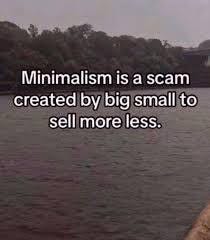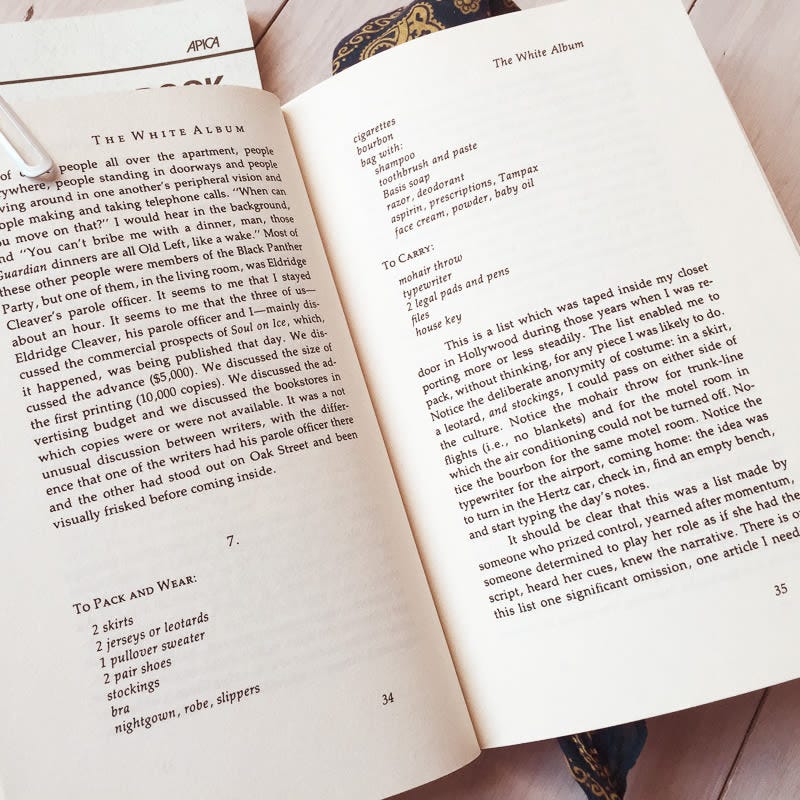Hello… you
You didn’t subscribe to this newsletter to read my political commentary so I’ll spare you my detailed thoughts on the U.S. election results. However. We’re in the business of talking about business. Like it or not, political or not (being apolitical is political, by the way), we’re already seeing changes in consumer trends, investments, and ye olde stock market.
I’m not a nerd about typefaces. But have you ever thought of the political leanings of the visuals we use and are subjected to? Helvetica is everywhere. It went from expressing modern, cosmopolitan sophistication to being the ubiquitous choice. Yet some associate Helvetica with authority and corporate dominance. What does it say about our society that the default choice is a non-choice, the only option being the conservative one? You can watch the 2007 documentary here.
My DMs are open should you want to discuss typefaces, politics or real estate.
xoxo Esther
💸 What I’m divesting from
🕳️ Faux minimalism.
Some personal news: October was a no-buy month for me. You might have heard I was buying a house? Not that a month’s worth of shopping and dining was going to make a world of difference. This is not an endorsement of the boomer “millennials can’t afford housing because they’re overspending on avocado toast” agenda. But the real estate project went from a likely possibility to a real thing that was happening over the course of a few weeks, and I had decided to put all my things in order. Reevaluate where I was overspending to focus on the right things.1
This whole absence of consumption got me thinking.
I’ve been an adult for long enough now to have seen currents come and go. I can’t call them trends – they’re bigger than that and have had a lasting impact on us.
We’ve seen the rise of normcore – was that the first -core? – 10 years ago.
Arguably a fashion movement (since it stands against trends) it ended up trickling down to other fields: graphic design, product design in general, beauty. Outside of the physical realm minimalism was also suddenly everywhere as a concept. Instead of upgrading or downgrading our life with cheaper or more expensive products, how do we approach levelgrading (don’t look it up, it’s a word I just made up) for better efficiency, for mental zen, and for a kaizen approach to doing things?
A subgenre of minimalism is the fallacy of the capsule wardrobe: we’ve been sold the idea that chic can only be attained by limiting our clothing options. So we trade beloved, unique and perhaps even quirky items for “timeless” pieces. As a result: everyone looks boring and basic.
Inevitably, the next thing that came up was in complete opposition to normcore: maximalism. Ushered by Alessandro Michele and his unique vision when he became the creative director of Gucci in 2015, the approach was more is more. Instantly recognisable, sparkly and perhaps a little bag-lady-ish. Outside of clothing, the concept translated to other areas: instead of going to a restaurant and having each person order a personal dish, small plates restaurants became inescapable, leading to crowded tables… and a $$ bill.
More recently: quiet luxury. Arguably more chic, it’s a rehash of normcore with a bit of class divide peppered in for good measure. The issue is that a Zara copy of a Brunello Cucinelli item can seem timeless in an Instagram post or a TikTok video but will look drab IRL and probably start falling apart after a few washes, defeating the purpose entirely.
–
We need to address the elephant in the changing room: social media.
The rise of TikTok, especially since 2020, has reshaped consumer behaviour by rapidly spreading trends. The tailored algorithms showcase lifestyles in engaging ways, driving impulse buying. Viral products can sell out within hours (!), and brands invest heavily in influencer partnerships and branded content.
Consumers feel they’re seeing honest peer reviews rather than polished ads, leading them to believe in the authenticity of content creators. Companies must respond faster to trends, adapting to demands shaped by TikTok’s fast-paced content cycle. Ultimately, TikTok accelerates decision-making, making it a key platform for discovery and instant consumer gratification.
Moreover, some of the content we’ve grown accustomed to leads to a schizophrenic experience as a viewer: on the one hand, you see hauls and PR package unboxings. These people showcase a quantity of products that could last a single person several lifetimes to use up! On the other hand, some of those same people we see as aspirational sell us products that are supposed to be the be-all, end-all… except they’re swapping them up day in and day out (see: #cleantok; the weird rich people replenishing their snack drawers; the people stocking up on multiple Stanley tumblers even though they’re supposedly a reusable container).
Where does that leave us? Consumption-core? Deinfluencing?
All of this is happening at a time when the masses struggle with paying for basic necessities.
📈 Bullish news
Americans Are Spending Big on Cosmetic Procedures — and Wall Street Is Cashing In [Bloomberg]
75 years of S&P 500 data: You make a lot more money holding for the long term than if you only invest when one party's in power [WT Wealth Management]
Trump win may usher in M&A revival [Axios]
Olivia Wilde is the next celebrity to launch her own VC firm [TechCrunch]
Live Nation is launching Side Hustles, a series giving a behind-the-scenes look at how celebrities run their brands. [The Hollywood Reporter]
Apple is reaching far back in time to turn The Oregon Trail into a big-budget movie [The Hollywood Reporter] Another proof of the known>new theory.
A New, TikTok Trend-led E-tailer Wants to Be the ‘Supreme’ of the Beauty Industry [WWD]. My take: this looks like the 2024 version of the subscription box craze with 4 minis from brands Glow Recipe, Topicals, Caliray, and Moroccanoil in a mini backpack for $88.
Reddit is profitable for the first time ever [Sherwood]
LVMH Ventures writes checks for up to $25M for 25% of Our Legacy [NYT]
Is Moncler trying to acquire Burberry? [The Stanza]
The next Anna Wintour? Meet Stellene Volandes, the Town & Country EIC. [NYT]
The new Ozempic? Novo Nordisk is testing a weight loss drug targeting 25% weight loss without increased side effects thanks to the new hormone amylin. [Bloomberg]
📉 Bearish news
Americans could see higher prices across a range of everyday goods if President-elect Trump raises tariffs as promised [NRF]
Addicted to love: how dating apps ‘exploit’ their users [The Guardian]. ICYMI: read my take on the subject here.
How Gen Z ended up in so much debt [Bloomberg]
The Netflix offices in France and the Netherlands were raided as part of a preliminary investigation into tax fraud laundering [Reuters]
Bad day for Mattel: Mattel’s ‘Wicked’ Movie Dolls Mistakenly List Porn Site on Packaging :( [Variety]
The Weekly Report
🍰 Catania: I finally tried the breast pastry I wrote about the other day… They say don’t meet your idols. Found it sickeningly sweet :)
📸 Paris: I went to a photography exhibition at Hôtel La Louisiane, an old-school left-bank spot. The photographs were shown across different rooms. I was particularly touched by Gil Lesage’s series showcasing her child’s transition. The hotel itself feels like a vestige of a bygone era, before the homogenisation of the hospitality industry.
For my French readers: here’s a good budget tracker to keep up with your expenses and revenue! If there’s demand for it I’m sure we could create an English version.
And here’s another one specifically tailored to a real estate project.











Typefaces, normcore, minimalism, history of fashion, cake, and finance reunited? Can't handle 😭💘